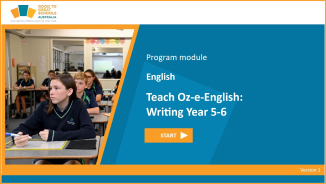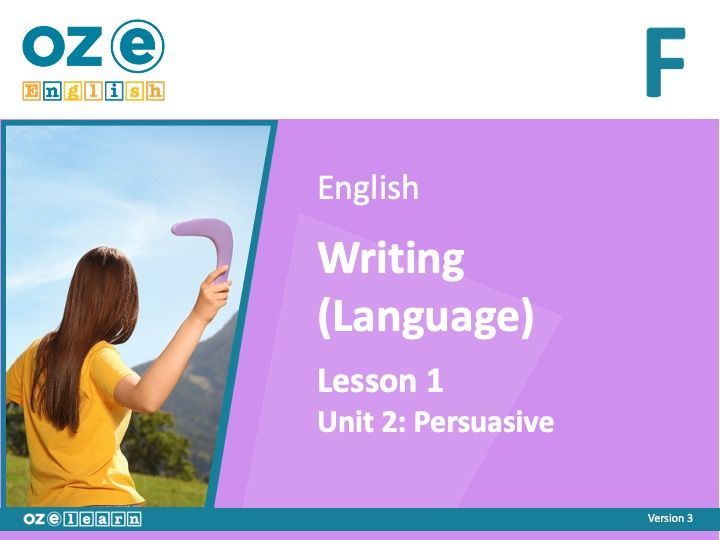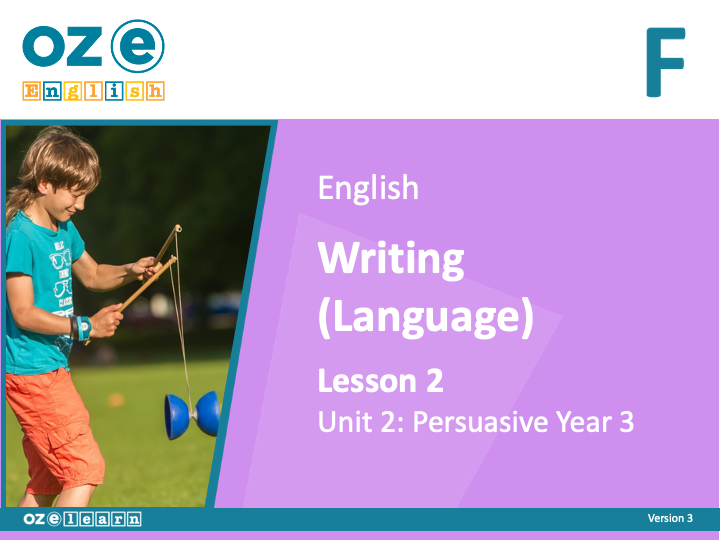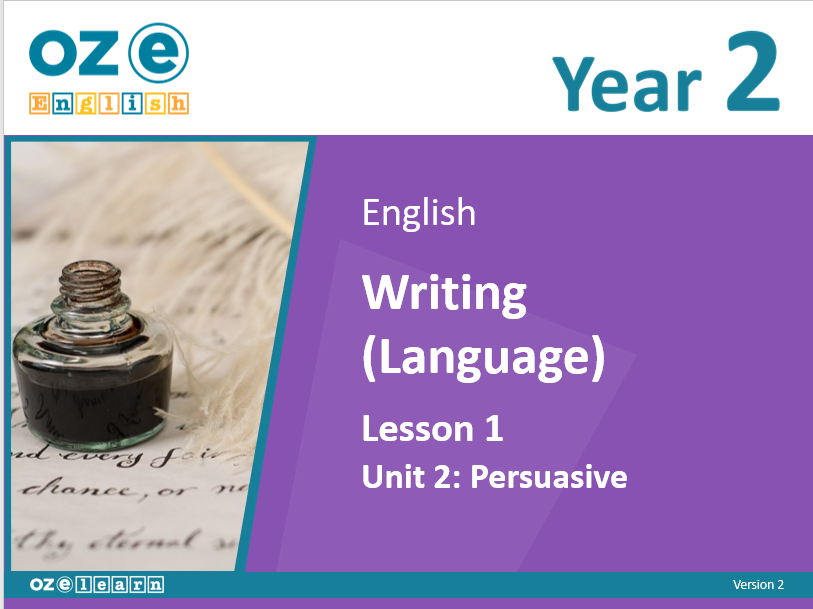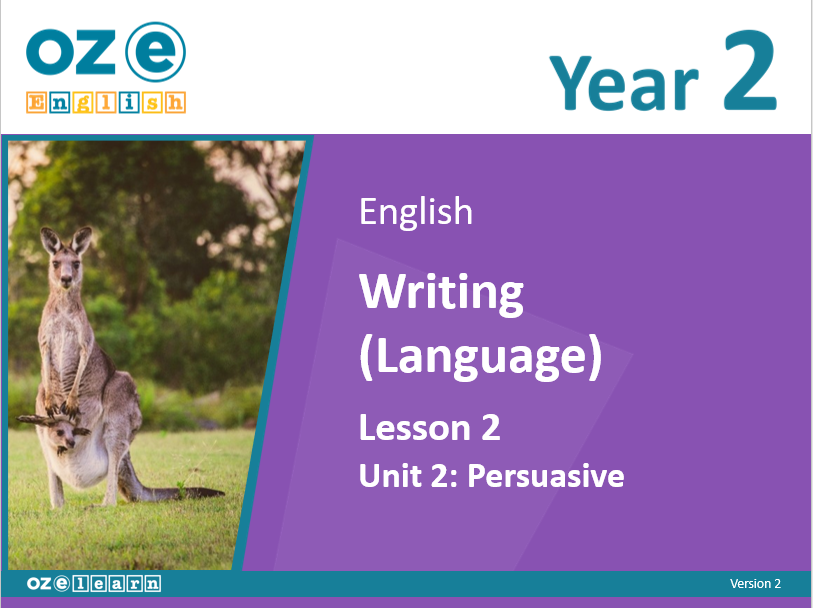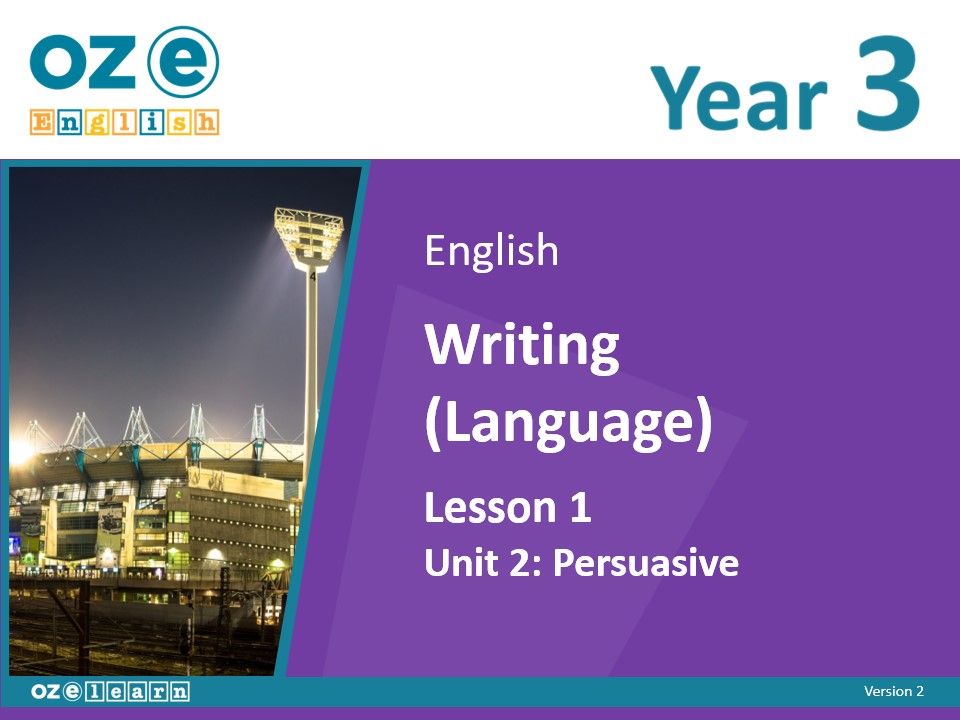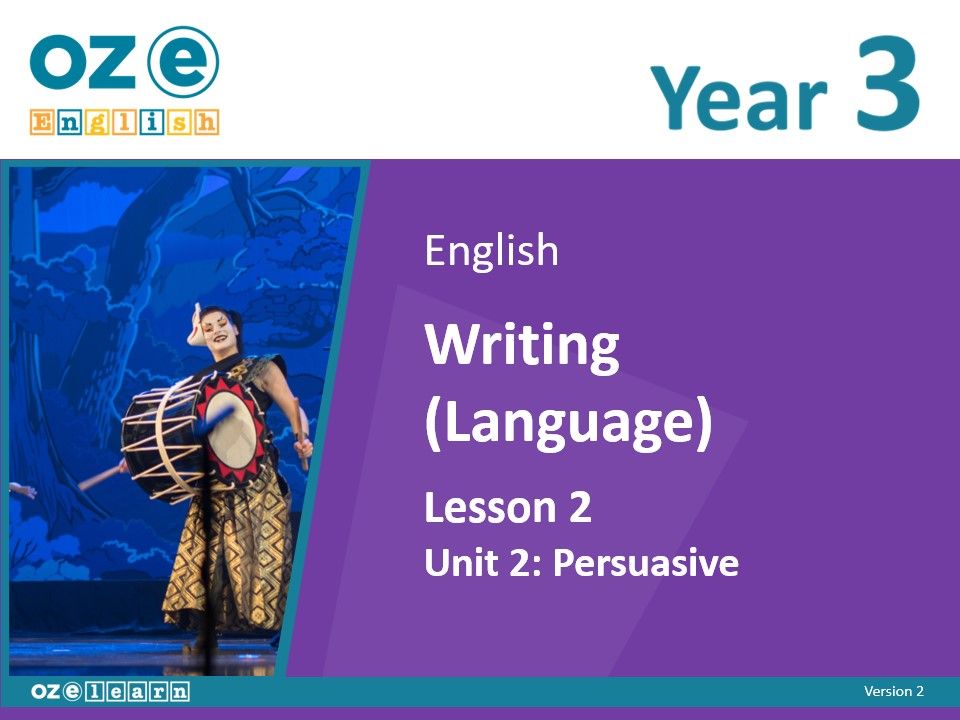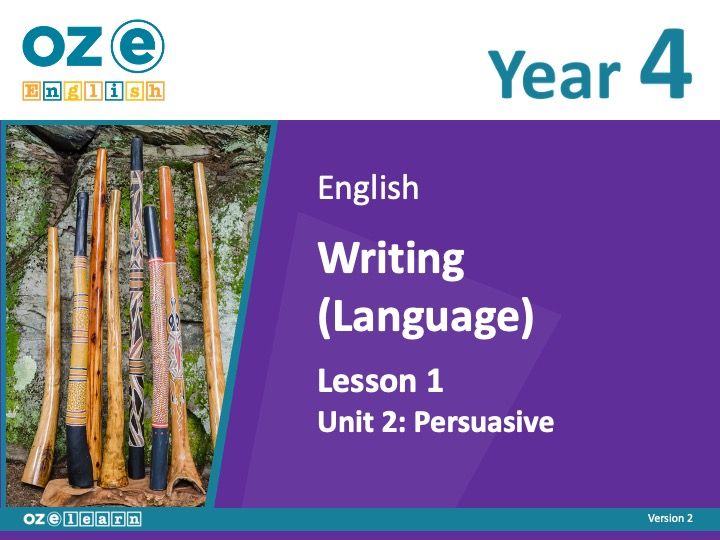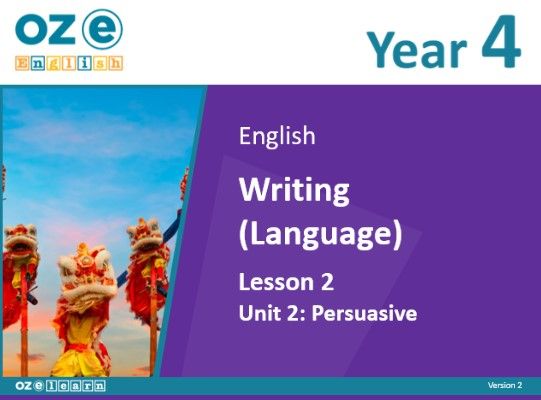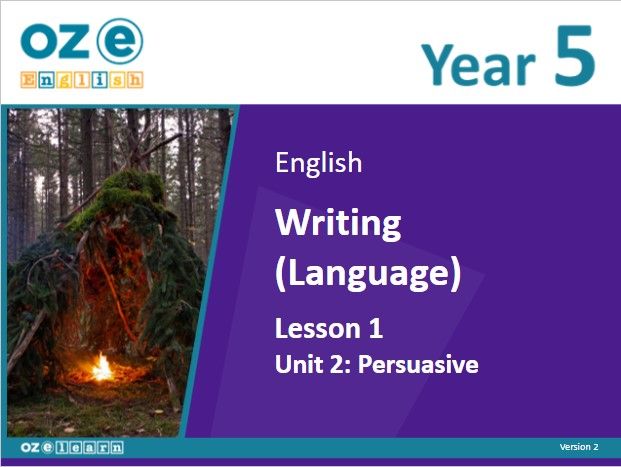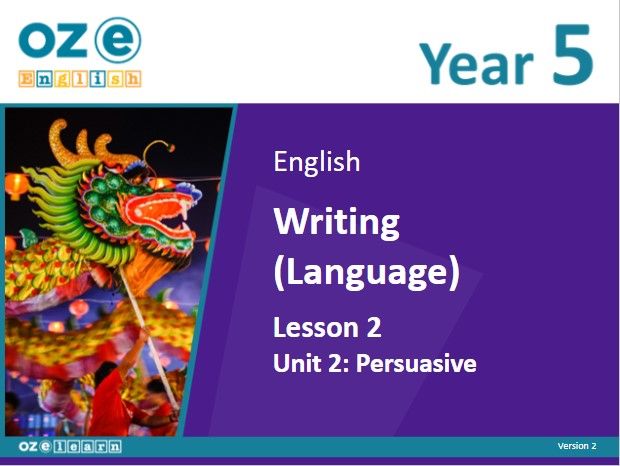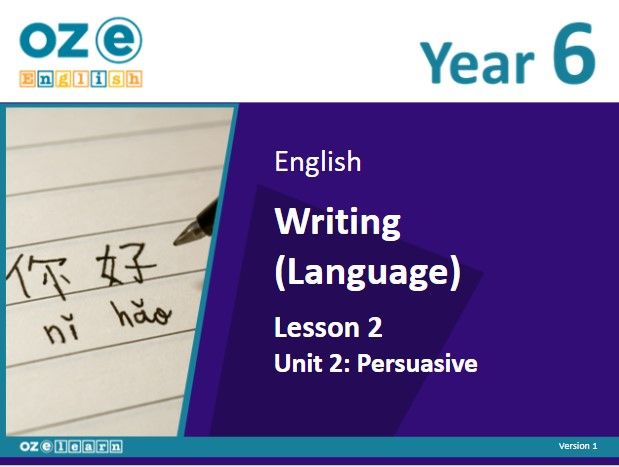Oz-e-English Writing (Language) Years F–6
Unit 2: Persuasive
Discontinuation Notice: Oz-e-English Writing (Language) Years F–6
GGSA is discontinuing the Oz-e-English Writing (Language) program as we are developing an improved program to better support schools. However, we understand that some schools are still using this program and may wish to continue doing so.
The program will remain available for download until 31 July 2025, after which it will be permanently removed from our membership platform. We encourage you to download any materials you wish to retain before this date.
If you have any questions, please contact us.
The Writing (Language) units align to the Australian Curriculum Content Descriptions for Language and Literacy
Free Starter Lessons
Year Overview
Australian Curriculum Content Descriptions
Overview
Oz-e-English: Writing (Language) Foundation Year is an English unit for Foundation Year students.
It aligns to the Australian Curriculum 8.4 Language Content Strands:
Text Structure and Organisation
Understand that punctuation is a feature of written text different from letters; recognise how capital letters are used for names, and that capital letters and full stops signal the beginning and end of sentences (ACELA1432).
Expressing and Developing Ideas
- Recognise that sentences are key units for expressing ideas (ACELA1435).
- Recognise that texts are made up of words and groups of words that make meaning (ACELA1434).
Phonics and Word Knowledge
- Recognise and generate rhyming words, alliteration patterns, syllables and sounds (phonemes) in spoken words (ACELA1439).
- Know how to read and write some high-frequency words and other familiar words (ACELA1817).
Note: Information on this page is subject to change as this program is currently being updated to align with version 9.0 of the Australian Curriculum. GGSA will release an updated version in early 2024.
Learning Objectives
In Lessons 1 to 10 students learn to:
- Say, make, trace and write a sentence about something I can do.
- Say, make, trace and write a sentence about something we can do.
- Say, make, trace and write a sentence about something they can do.
- Say, make, trace and write a sentence about something I like to do.
- Say, make, trace and write a sentence about something we like to do.
Success Criteria
- Understand their texts can reflect their own experiences.
- Identify and describe likes and dislikes about familiar texts, objects, characters and events.
- Communicate clearly in informal group and whole class settings.
- Retell events and experiences with peers and known adults.
- Identify and use rhyme, and orally blend and segment sounds in words.
- Use familiar words and phrases and images to convey ideas when writing.
- Show evidence of letter and sound knowledge, beginning writing behaviours and experimentation with capital letters and full stops.
- Form known upper- and lower-case letters correctly.
Assessment
Progress tests are conducted after Lesson 5. They allow teachers to monitor student understanding of the concepts taught over the past five lessons and to identify where reteaching is needed.
The Teaching Guide contains the progress test script and there is a handout for students to write their answers on.
End-of-Unit Assessment
Week 10 is the end-of-unit assessment, which has the same variety of question formats as the progress tests (e.g. multiple choice, filling in blanks/punctuation, editing, constructing, and improving sentences) to assess student mastery of sentence level writing development from the unit.
The Teaching Guide contains the testing questions and the end-of-unit assessment handout for students to write their answers on.
Australian Curriculum Content Descriptions
Overview
It aligns to the Australian Curriculum Language Content Strands:
Text Structure and Organisation
- Understand that the purposes texts serve shape their structure in predictable ways (ACELA1447).
- Understand patterns of repetition and contrast in simple texts (ACELA1448).
- Recognise that different types of punctuation, including full stops, question marks and exclamation marks, signal sentences that make statements, ask questions, express emotion or give commands (ACELA1449).
Expressing and Developing Ideas
- Identify the parts of a simple sentence that represent ‘What’s happening?’, ‘What state is being described?’, ‘Who or what is involved?’ and the surrounding circumstances (ACELA1451).
- Explore differences in words that represent people, places and things (nouns, including pronouns), happenings and states (verbs), qualities (adjectives) and details such as when, where and how (adverbs) (ACELA1452).
Phonics and Word Knowledge
- Use visual memory to read and write high-frequency words (ACELA1821).
Note: Information on this page is subject to change as this program is currently being updated to align with version 9.0 of the Australian Curriculum. GGSA will release an updated version in early 2024.
Learning Objectives
In Lessons 1 to 10, students learn to:
- Write, edit and improve simple sentences (present tense).
- Write, edit and improve simple sentences (past tense).
- Write, edit and improve simple sentences (future tense).
Success Criteria
- Understand how characters in texts are developed and give reasons for personal preferences.
- Create texts that show understanding of the connection between writing, speech and images.
- Create short texts for a small range of purposes.
- Interact in pair, group and class discussions, taking turns when responding.
- Make short presentations on familiar topics.
- Provide details about ideas or events, and details about the participants in those events.
- Spell high-frequency words and words with regular spelling patterns accurately.
- Use capital letters and full stops and form all upper- and lower-case letters correctly.
Assessment
Progress tests are conducted after Lesson 5. They allow teachers to monitor student understanding of the concepts taught over the past five lessons and to identify where reteaching is needed.
The Teaching Guide contains the progress test script and there is a handout for students to write their answers on.
End-of-Unit Assessment
Week 10 is the end-of-unit assessment, which has the same variety of question formats as the progress tests (e.g. multiple choice, filling in blanks/punctuation, editing, constructing, and improving sentences) to assess student mastery of sentence level writing development from the unit.
The Teaching Guide contains the testing questions and the end-of-unit assessment handout for students to write their answers on.
Australian Curriculum Content Descriptions
Overview
Language Content Strands:
Text Structure and Organisation
- Understand how texts are made cohesive through language features, including word associations, synonyms, and antonyms (ACELA1464).
- Recognise that capital letters signal proper nouns and commas are used to separate items in lists (ACELA1465).
Expressing and Developing Ideas
- Understand that simple connections can be made between ideas by using a compound sentence with two or more clauses usually linked by a coordinating conjunction (ACELA1467).
- Understand that nouns represent people, places, concrete objects and abstract concepts; that there are three types of nouns: common, proper and pronouns; and that noun groups/phrases can be expanded using articles and adjectives (ACELA1468).
Phonics and Word Knowledge
- Build morphemic word families using knowledge of prefixes and suffixes (ACELA1472)
Note: Information on this page is subject to change as this program is currently being updated to align with version 9.0 of the Australian Curriculum. GGSA will release an updated version in early 2024.
Learning Objectives
In Lessons 1 to 10, students learn to:
- Write, edit and improve sentences that support an opinion (pronouns).
- Write, edit and improve sentences against an opinion (pronouns).
- Write, edit and improve sentences that support an opinion (plural pronouns).
- Write, edit and improve sentences against an opinion (plural pronouns).
- Write, edit and improve sentences that support an opinion (proper nouns).
- Write, edit and improve sentences against an opinion (proper nouns).
- Write, edit and improve sentences that ask for an opinion (Why).
- Write, edit and improve sentences that ask for an opinion (How).
- Write, edit and improve descriptive sentences that support an opinion (adjective).
- Write, edit and improve descriptive sentences against an opinion (adjective).
Success Criteria
- Use everyday language features and topic-specific vocabulary when discussing ideas and experiences.
- Explain preferences for aspects of texts using other texts as comparisons.
- Create texts that show how images support the meaning of the text.
- Create texts, drawing on their own experiences, their imagination and information they have learnt.
- Use a variety of strategies to engage in group and class discussions and make presentations.
- Spell words with regular spelling patterns and spell words with less common long vowel patterns accurately.
- Use punctuation accurately and write words and sentences legibly using unjoined upper- and lower-case letters.
Assessment
Progress tests are conducted after Lesson 5. They allow teachers to monitor student understanding of the concepts taught over the past five lessons and to identify where reteaching is needed.
The Teaching Guide contains the progress test script and there is a handout for students to write their answers on.
End-of-Unit Assessment
Week 10 is the end-of-unit assessment, which has the same variety of question formats as the progress tests (e.g. multiple choice, filling in blanks/punctuation, editing, constructing, and improving sentences) to assess student mastery of sentence level writing development from the unit.
The Teaching Guide contains the testing questions and the end-of-unit assessment handout for students to write their answers on.
Australian Curriculum Content Descriptions
Overview
It aligns to the Australian Curriculum Language Content Strands:
Text Structure and Organisation
- Understand how different types of texts vary in use of language choices, depending on their purpose and context (for example, tense and types of sentences) (ACELA1478).
- Know that word contractions are a feature of informal language and that apostrophes of contraction are used to signal missing letters (ACELA1480).
Expressing and Developing Ideas
- Understand that a clause is a unit of grammar usually containing a subject and a verb and that these need to be in agreement (ACELA1481).
- Understand that verbs represent different processes, for example doing, thinking, saying, and relating and that these processes are anchored in time through tense (ACELA1482).
- Learn extended and technical vocabulary and ways of expressing opinion including modal verbs and adverbs (ACELA1484).
Note: Information on this page is subject to change as this program is currently being updated to align with version 9.0 of the Australian Curriculum. GGSA will release an updated version in early 2024.
Learning Objectives
In Lessons 1 to 10, students learn to:
- Write, edit and improve sentences that introduce a persuasive text.
- Write, edit and improve sentences that support an argument (for).
- Write, edit and improve sentences that do not support an argument (against).
- Write, edit and improve sentences that provide reasons for an opinion.
- Write, edit and improve sentences that provide reasons against an opinion.
- Write, edit and improve sentences that provide an example for and against an opinion.
- Write, edit and improve sentences that provide examples for and against an opinion (lists).
- Write, edit and improve rhetorical questions.
- Write, edit and improve sentences that restate an opinion.
Success Criteria
- Understand how language features are used to link and sequence ideas.
- Understand how language can be used to express feelings and opinions on topics.
- Include writing and images in texts to express and develop, in some detail, experiences, events, information, ideas and characters.
- Create a range of texts for familiar and unfamiliar audiences.
- Contribute actively to class and group discussions, asking questions, providing useful feedback and making presentations.
- Demonstrate understanding of grammar and choose vocabulary and punctuation appropriate to the purpose and context of their writing.
- Use knowledge of letter-sound relationships including consonant and vowel clusters and high-frequency words to spell words accurately.
- Re-read and edit their writing, checking their work for appropriate vocabulary, structure and meaning.
- Write using joined letters that are accurately formed and consistent in size.
Assessment
Progress Test
Progress tests are conducted after Lesson 5. They allow teachers to monitor student understanding of the concepts taught over the past five lessons and to identify where reteaching is needed.
The Teaching Guide contains the progress test script and there is a handout for students to write their answers on.
End-of-Unit Assessment
Week 10 is the end-of-unit assessment, which has the same variety of question formats as the progress tests (e.g. multiple choice, filling in blanks/punctuation, editing, constructing, and improving sentences) to assess student mastery of sentence level writing development from the unit.
The Teaching Guide contains the testing questions and the end-of-unit assessment handout for students to write their answers on.
Australian Curriculum Content Descriptions
Overview
It aligns to the Australian Curriculum Language Content Strands:
Text Structure and Organisation
- Understand how texts vary in complexity and technicality depending on the approach to the topic, the purpose and the intended audience (ACELA1490).
- Understand how texts are made cohesive through the use of linking devices including pronoun reference and text connectives (ACELA1491).
- Recognise how quotation marks are used in texts to signal dialogue, titles and quoted (direct) speech (ACELA1492).
Expressing and Developing Ideas
- Understand that the meaning of sentences can be enriched through the use of noun groups/phrases and verb groups/phrases and prepositional phrases (ACELA1493).
- Investigate how quoted (direct) and reported (indirect) speech work in different types of text (ACELA1494).
- Understand how adverb groups/phrases and prepositional phrases work in different ways to provide circumstantial details about an activity (ACELA1495).
- Incorporate new vocabulary from a range of sources into students’ own texts including vocabulary encountered in research (ACELA1498).
Note: Information on this page is subject to change as this program is currently being updated to align with version 9.0 of the Australian Curriculum. GGSA will release an updated version in early 2024.
Learning Objectives
In Lessons 1 to 10, students learn to:
- Write, edit and improve sentences that introduce a persuasive text.
- Write, edit and improve sentences that support an argument (text connectives).
- Write, edit and improve sentences that do not support an argument (text connectives).
- Write, edit and improve sentences that provide reasons for an opinion (subordinating conjunctions).
- Write, edit and improve sentences that provide reasons against an opinion (subordinating conjunctions).
- Write, edit and improve sentences that provide an example for and against an opinion (subordinating conjunctions).
- Write, edit and improve sentences that provide examples for and against an opinion (lists).
- Write, edit and improve rhetorical questions (word contractions).
- Write, edit and improve sentences that restate an opinion.
Success Criteria
- Use language features to create coherence and add detail to their texts.
- Understand how to express an opinion based on information in a text.
- Create texts that show understanding of how images and detail can be used to extend key ideas.
- Create structured texts to explain ideas for different audiences.
- Make presentations and contribute actively to class and group discussions, varying language according to context.
- Demonstrate understanding of grammar, select vocabulary from a range of resources and use accurate spelling and punctuation, re-reading and editing their work to improve meaning.
Assessment
Progress Test
Progress tests are conducted after Lesson 5. They allow teachers to monitor student understanding of the concepts taught over the past five lessons and to identify where reteaching is needed.
The Teaching Guide contains the progress test script and there is a handout for students to write their answers on.
End-of-Unit Assessment
Week 10 is the end-of-unit assessment, which has the same variety of question formats as the progress tests (e.g. multiple choice, filling in blanks/punctuation, editing, constructing, and improving sentences) to assess student mastery of sentence level writing development from the unit.
The Teaching Guide contains the testing questions and the end-of-unit assessment handout for students to write their answers on.
Australian Curriculum Content Descriptions
Overview
Text Structure and Organisation
- Understand how texts vary in purpose, structure and topic, as well as the degree of formality (ACELA1504).
- Understand how the grammatical category of possessives is signalled through apostrophes and how to use apostrophes with common and proper nouns (ACELA1506).
Expressing and Developing Ideas
- Understand the difference between main and subordinate clauses and that a complex sentence involves at least one subordinate clause (ACELA1507).
- Understand how noun groups/phrases and adjective groups/phrases can be expanded in a variety of ways to provide a fuller description of the person, place, thing or idea (ACELA1508).
- Understand the use of vocabulary to express greater precision of meaning, and know that words can have different meanings in different contexts (ACELA1512).
Note: Information on this page is subject to change as this program is currently being updated to align with version 9.0 of the Australian Curriculum. GGSA will release an updated version in early 2024.
Learning Objectives
In Lessons 1 to 10, students learn to:
- Write, edit and improve sentences that introduce a persuasive text.
- Write, edit and improve opinion statements that are in support of an argument.
- Write, edit and improve opinion statements that are against an argument.
- Write, edit and improve complex sentences that provide reasons for an opinion (text connectives).
- Write, edit and improve complex sentences that provide reasons against an opinion (text connectives).
- Write, edit and improve a supporting argument using the persuasive-evidence technique.
- Write, edit and improve a supporting argument using the analogy technique.
- Write, edit and improve supporting arguments using the cause-and-effect technique.
- Write, edit and improve rhetorical questions that include metaphors.
Success Criteria
- Use language features to show how ideas can be extended.
- Develop and explain a point of view about a text, selecting information, ideas and images from a range of resources.
- Create imaginative, informative and persuasive texts for different purposes and audiences.
- Make presentations that include multimodal elements for defined purposes.
- Contribute actively to class and group discussions, taking into account other perspectives.
- Demonstrate understanding of grammar using a variety of sentence types when writing.
- Select specific vocabulary and use accurate spelling and punctuation.
- Edit their work for cohesive structure and meaning.
Assessment
Progress Test
Progress tests are conducted after Lesson 5. They allow teachers to monitor student understanding of the concepts taught over the past five lessons and to identify where reteaching is needed.
The Teaching Guide contains the progress test script and there is a handout for students to write their answers on.
End-of-Unit Assessment
Week 10 is the end-of-unit assessment, which has the same variety of question formats as the progress tests (e.g., multiple choice, filling in blanks/punctuation, editing, constructing, and improving sentences) to assess student mastery of sentence level writing development from the unit.
The Teaching Guide contains the testing questions and the end-of-unit assessment handout for students to write their answers on.
Australian Curriculum Content Descriptions
Overview
Text Structure and Organisation
- Understand how authors often innovate on text structures and play with language features to achieve particular aesthetic, humorous and persuasive purposes and effects (ACELA1518).
- Understand the uses of commas to separate clauses (ACELA1521).
Expressing and Developing Ideas
- Investigate how complex sentences can be used in a variety of ways to elaborate, extend and explain ideas (ACELA1522).
- Understand how ideas can be expanded and sharpened through careful choice of verbs, elaborated tenses and a range of adverb groups/phrases (ACELA1523).
- Investigate how vocabulary choices, including evaluative language can express shades of meaning, feeling and opinion (ACELA1525).
Note: Information on this page is subject to change as this program is currently being updated to align with version 9.0 of the Australian Curriculum. GGSA will release an updated version in early 2024.
Learning Objectives
In Lessons 1 to 10, students learn to:
- Write, edit and improve rhetorical questions that introduce a persuasive text.
- Write, edit and improve opinion statements that are in support of an argument (adverbial phrases).
- Write, edit and improve opinion statements that are against an argument (adverbial clauses).
- Write, edit and improve complex sentences that provide reasons for an opinion (text connectives).
- Write, edit and improve complex sentences that provide reasons against an opinion (text connectives).
- Write, edit and improve a supporting argument using the persuasive-evidence technique.
- Write, edit and improve a supporting argument using the analogy technique.
- Write, edit and improve supporting arguments using the cause-and-effect technique.
- Write, edit and improve rhetorical questions that include metaphors.
Success Criteria
- Understand how language features and language patterns can be used for emphasis.
- Show how specific details can be used to support a point of view.
- Explain how their choices of language features and images are used.
- Create detailed texts elaborating on key ideas for a range of purposes and audiences.
- Make presentations and contribute actively to class and group discussions, using a variety of strategies for effect.
- Demonstrate an understanding of grammar and make considered vocabulary choices to enhance cohesion and structure in their writing.
- Use accurate spelling and punctuation for clarity and make and explain editorial choices based on criteria.
Assessment
Progress Test
Progress tests are conducted after Lesson 5. They allow teachers to monitor student understanding of the concepts taught over the past five lessons and to identify where reteaching is needed.
The Teaching Guide contains the progress test script and there is a handout for students to write their answers on.
End-of-Unit Assessment
Week 10 is the end-of-unit assessment, which has the same variety of question formats as the Progress tests (e.g., multiple choice, filling in blanks/punctuation, editing, constructing, and improving sentences) to assess student mastery of sentence level writing development from the unit.
The Teaching Guide contains the testing questions and the end-of-unit assessment handout for students to write their answers on.
Other Units
Lesson Design
Lesson Objective
Success Criteria
Activating Prior Knowledge
I Do
We Do
Apple Question
You Do
Revise
Professional Learning
